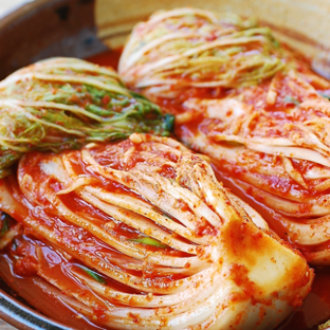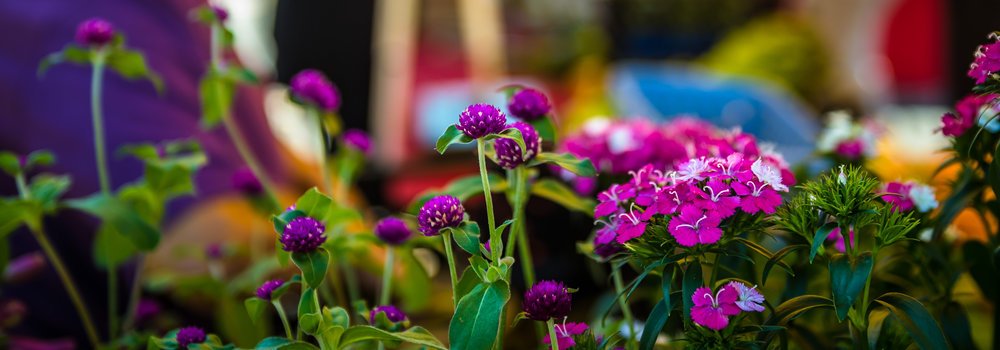
Staff
Traditional Kimchi (Napa Cabbage Kimchi)
Kimchi, a staple in Korean cuisine, is a traditional side dish of salted and fermented vegetables, such as Napa cabbage and Korean radish, made with a widely varying selection of seasonings including gochugaru, spring onions, garlic, ginger, and jeotgal, etc. Korean-American home chef and blogger Hyosun knows her way around traditional Korean dishes and shows us how it’s done with this Traditional Kimchi featuring Napa cabbage. Fresh Napa cabbage is making its way into markets and can be found in both the CCFM and Market Mommas Club boxes this week! Perfect for folks clearing out their fridges or saving the season, and does not require electricity to prepare!

Ingredients
- 1 large Napa cabbage about 5 to 6 pounds, or 2 small (about 3 pounds each)
- 1 cup Korean coarse sea salt for making kimchi
- 5 cups water
- 1 pound Korean radish, mu or moo (무) mu/moo
- 1/4 Korean pear (배) optional
- 3 - 4 scallions
- 1 piece dashima (about 2 to 3 inch square) Boil it in 1.5 cups of water for 5 minutes
Seasonings
- 1 tablespoon glutinous rice powder, 찹쌀가루 Mix it with 1/2 cup water (or optional dashima broth) simmer over low heat until it thickens to a thin paste and cool. Yields about 3 - 4 tablespoons.
- 1/2 cup gochugaru, 고추가루, Korean red chili pepper flakes - adjust to your taste
- 1/4 cup salted shrimp (saeujeot), 새우젓, finely minced
- 3 - 4 raw shrimps, about 2 ounces, finely minced or ground - optional
- 3 tablespoons myulchiaekjeot fish sauce, 멸치액젓
- 3 tablespoons minced garlic
- 1 teaspoon grated ginger
- 1 teaspoon sesame seeds - optional
- 1/2 cup water or dashima (dried kelp) broth
Directions
Cut the thick white part of the cabbage lengthwise in half. Then, slowly pull apart by hand to separate into two pieces. Do the same for each half to make quarters. Running the knife through all the way would unnecessarily cut off the cabbage leaves.
In a large bowl, dissolve 1/2 cup of salt in 5 cups of water. Thoroughly bathe each cabbage quarter in the salt water one at a time, shake off excess water back into the bowl, and then transfer to another bowl.
Using the other half cup of salt and starting from the outermost leaf, generously sprinkle salt over the thick white part of each leaf (similar to salting a piece of meat). Try to salt all the cabbage quarters with 1/2 cup salt, but you can use a little more if needed. Repeat with the rest of the cabbage quarters. Pour the remaining saltwater from the first bowl over the cabbage. Set aside for about 6 - 8 hours, rotating the bottom ones to the top every 2 - 3 hours.
The cabbages should be ready to be washed when the white parts of the leaves are easily bendable. Rinse thoroughly 3 times, especially between the white parts. Drain well, cut side down.
Meanwhile, make the optional dashima broth by boiling a small piece (2 to 3-inch square) in 1.5 cups of water for 5 minutes, and cool. Mix the rice powder with 1/2 cup water (or optional dashima broth) and simmer over low heat, stirring occasionally, until it thickens to a thin paste, and cool.
Prepare the garlic, ginger, and saeujeot. Combine all the seasoning ingredients, including the rice paste and about 1/2 cup water (or the optional dashima broth), and mix well. Set aside until the red pepper flakes to dissolve slightly and become pasty.
Cut the radish and optional pear into matchsticks (use a mandoline if desired), transferring to a large bowl. Cut the scallions diagonally into about 1-inch long pieces. Add the prepared seasoning mix to the radish, and mix well by hand. Throw in the scallions, and mix everything lightly. Taste a little bit. It should be a little too salty to eat as is. You can add salt, more salted shrimp or fish sauce, as needed. Let it sit for about 30 minutes to allow the flavors to meld nicely.
Cut off the tough stem part from each cabbage quarter, leaving enough to hold the leaves together. Place one cabbage quarter in the bowl with the radish mix. Spread the radish mix over each leaf, one to two tablespoons for large leaves. (Eyeball the stuffing into 4 parts and use one part for each cabbage quarter.)
Fold the leaf part of the cabbage over toward the stem and nicely wrap it with the outermost leaf. Place it, cut side up, in a jar or airtight container. Repeat with the remaining cabbages. Once all the cabbages are in the jar or airtight container, press down hard to remove air pockets. Rinse the bowl that contained the radish mix with 1/2 cup of water (or any remaining optional dashima broth) and pour over the kimchi.
Leave it out at room temperature for a full day or two, depending on the weather and how fast you want your kimchi to ripen. A half-day is recommended during hot summer days. Then, store in the fridge.
Note:
Although you can start eating it any time, kimchi needs about two weeks in the fridge to fully develop the flavors. It maintains great flavor and texture for several weeks.
About Us





